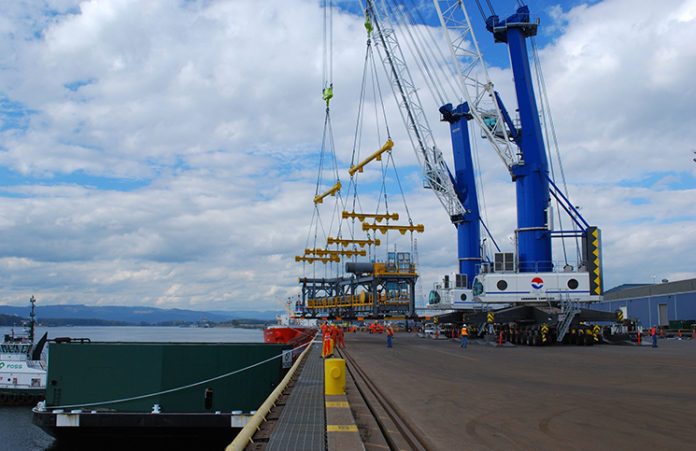
The Port of Vancouver USA is coming off of a successful 2019. They received a record-breaking wind blade shipment, imported more Subarus than any other port in the U.S. and are generating an annual benefit of $3.8 billion to the region – more than ever before. In addition, the port continued to demonstrate its commitment to the environment and the Vancouver community by opening new sections of bike/pedestrian pathways, achieving LEED Gold status for the Terminal 1 Waterfront Development Project and passing a renewable energy policy.
Looking to 2020, the outlook remains positive for business, and the port is bullish on the opportunities ahead. The bulk of the port’s revenue is generated from their maritime business, which in 2020 will see significant increases in wind energy cargoes coming across the docks.
“It’s safe to say that we’re going to have a record year when it comes to the movement of wind products,” said Alex Strogen, Chief Commercial Officer at the port. “We are looking at handling over 2,000 wind energy components in 2020, some of which will be the longest brought into North America to date. Our heavy-lift cranes, available laydown space and skilled work force make us an ideal location to handle these types of products and we’re excited about the year ahead.”
The Subaru business also remains strong. A total of 85,000 vehicles are expected to come through the port in 2020. With the company’s brand loyalty here in the Northwest and throughout the nation, the long-term outlook continues to be positive.
Other commodities, however, saw direct impacts from trade uncertainties and have a less predictable outlook. United Grain, an extremely important anchor tenant for the port, saw low volumes of soybean exports in 2018. This past year, however, exports rebounded and are currently up nearly 50% over the same period in 2018. Other agricultural exports, like wheat, look to be strong next year and the port is hopeful that trade policy will have a positive impact on business certainty going forward.
Steel imports, on the other hand, are just starting to feel the pain of tariffs. With a slacking demand for imported steel products, the port is expecting a downturn in 2020.
“The trade challenges are certainly impacting the port in the near term,” said Julianna Marler, Chief Executive Officer. “But we have worked hard over the years to diversify our cargo and tenants, and that has been critical to minimizing the impacts of tariffs on our overall productivity.”
On the industrial side, the port is moving ahead full steam. They are seeing a wide range of businesses interested in Southwest Washington, and Vancouver in particular. In just the last five years, over $100 million was invested in the port’s Centennial Industrial Park, demonstrating a strong interest in the community and acknowledging the need for industrial space in the region. While the port is currently at 99% occupancy, they have additional room to grow and attract new businesses to the area.
“The port continues to act on the Commission’s vision to grow jobs,” said Mike Schiller, the port’s Director of Business Development. “There is strong interest from businesses looking to locate and grow in the Vancouver area, and factors like our access to the I-5 corridor, Class I rail lines, deep draft Columbia River, and the Portland airport encourage tenants and others to make investments. The port is doing its best to identify the right partners for our community and increase economic opportunities right here in Southwest Washington.”
Another key priority for the port is further development of their signature Terminal 1 project. If you visit the waterfront in 2020, you’ll see a flurry of activity from ground stabilization and construction of the AC Hotel by Marriott, to work on the amphitheater and planning for the northern portion of the site.
The port is also anticipating a banner year for Mark Matthias’ Warehouse ‘23, the popular restaurant and event space located in the former Red Lion Hotel at Terminal 1. Matthias will operate Warehouse ‘23 through the end of 2020, at which point the port will begin the process of removing the building. Future plans for the site include a new dock, a public marketplace, bike and walking trails and more.
Woven into all the port’s planning to grow responsibly is their smart growth initiative. Terminal 1, in particular, has a certified LEED Gold Neighborhood Plan, which is designed to reduce water use, and increase wildlife protections, energy efficiency, pollution control and more. The sustainable development plan also requires all new buildings at the site to be constructed and certified to LEED Gold standards or better.
The port is excited about the year to come and the long-term possibilities on the horizon. Their growth and investments today will generate increased jobs and long-term benefits for our community and the broader Southwest Washington region well into the future.
Heather Stebbings is director of communications for the Port of Vancouver USA. She can be reached at hstebbings@portvanusa.com.



